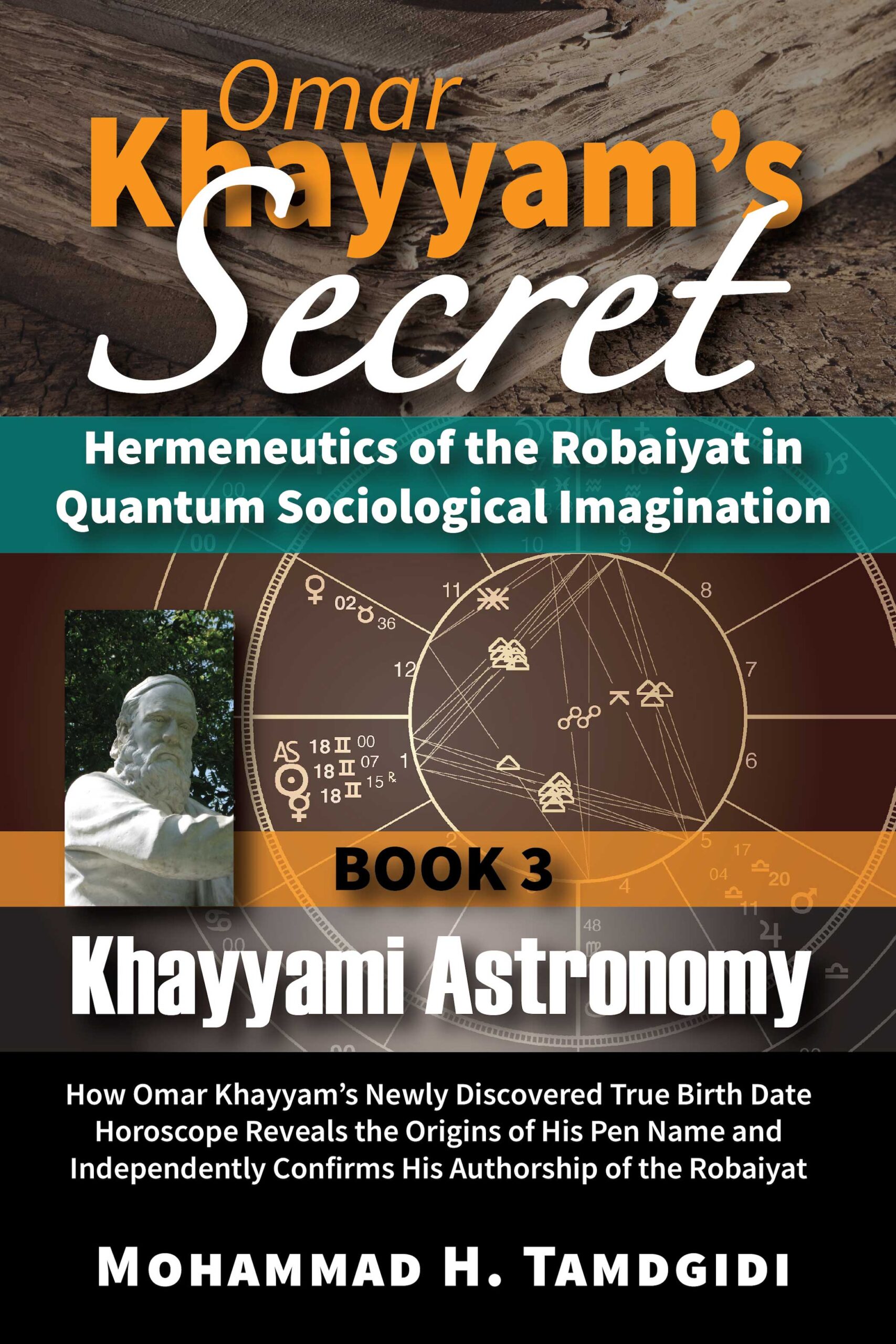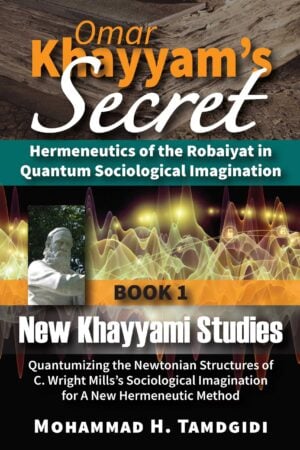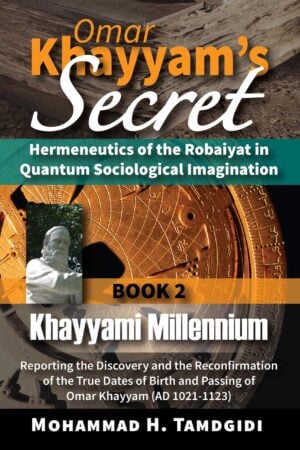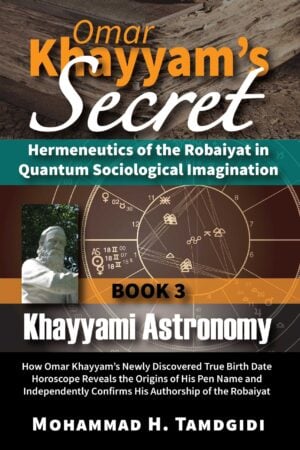Book Section: CHAPTER V — Discovering the Signature Robai of Omar Khayyam, Leading to An Independent and Final Confirmation of His Authorship of the Robaiyat — by Mohammad H. Tamdgidi
$20.00
This essay, titled “Discovering the Signature Robai of Omar Khayyam, Leading to An Independent and Final Confirmation of His Authorship of the Robaiyat,” is the fifth chapter of the book Khayyami Astronomy: How the Newly Discovered True Birth Horoscope of Omar Khayyam Reveals the Origins of His Pen Name and Independently Confirms His Authorship of the Robaiyat, which is the third volume of the twelve-book series Omar Khayyam’s Secret: Hermeneutics of the Robaiyat in Quantum Sociological Imagination, authored by Mohammad H. Tamdgidi.
Description
Abstract
This essay, titled “Discovering the Signature Robai of Omar Khayyam, Leading to An Independent and Final Confirmation of His Authorship of the Robaiyat,” is the fifth chapter of the book Khayyami Astronomy: How the Newly Discovered True Birth Horoscope of Omar Khayyam Reveals the Origins of His Pen Name and Independently Confirms His Authorship of the Robaiyat, which is the third volume of the twelve-book series Omar Khayyam’s Secret: Hermeneutics of the Robaiyat in Quantum Sociological Imagination, authored by Mohammad H. Tamdgidi.
In this chapter and two more chapters to follow Tamdgidi aims to intersect the findings of this book and series, so far, with a few selections from Khayyami quatrains. The reader may recall from what the author stated and explained in the first, methodological, book of this series that he uses the expression “Khayyami Robaiyat,” or “Khayyami quatrains,” as a non-dualistic, quantum conceptual device standing for the superposed possibility of a quatrain attributed to Khayyam being simultaneously his or not.
This quantum, probabilistic, methodological approach which implies a quantum reality eschewing dualistic presumptions of something being A or non-A, allows us to give equal attention to all possibilities without presumptively collapsing them into one or another possibility in advance, in an a priori way.
The author’s purpose is to consider how the definitive and unprecedented progress we have made in this series of discovering at last the true date of birth of Omar Khayyam in AD 1021 and reconfirming his date of passing in AD 1123, plus the hermeneutic astrological interpretations we have advanced so far (in the previous chapter) regarding Khayyam’s horoscope leading us to a different interpretation of the origins of his pen name “Khayyam,” can shed any light, from a hermeneutic point of view on the meanings found across the various extant Khayyami quatrains, on the attributability of one or another Khayyami quatrain to the historical Omar Khayyam.
Among the quatrains attributed to Omar Khayyam as listed in Swāmī Govinda Tīrtha The Nectar of Grace: Omar Khayyam’s Life and Works (1941), there is a neglected quatrain that has been almost entirely ignored in nearly all official collections, at home in Iran or abroad—one which Tamdgidi has used as an epigraph to the second book of the series.
This quatrain is numbered ix.34 (or 304, in another numbering system), in Tīrtha (1941:182), and among its few manuscript sources is an earliest one dating to AD 1584, that is, about 461 solar years after Khayyam’s passing in AD 1123, and about 437 solar years ago as of the publication date of the present book (2021), labeled by Tīrtha as RPb.
آن روز كه اين گنبد مينا بستند
وين نقطه چو بر ميان جوزا بستند
تا روز ازل بسان آتش بر شمع
عشقت به هزار رشته بر ما بستند
— رباعى خيامى
On that day when they fastened this blue dome above,
Then fastened this dot to mid-Gemini thereof,
Like a candle’s flame burning for eternity
They fastened me with a thousand threads to Thy Love.
— Khayyami Robai (Tamdgidi translation)
Based on a close examination of the content and form of the above quatrain while comparing it to a very different “vagrant” found in the collection of the mystic Abu Said Abol-Kheyr, to whom Tīrtha refers in his book, Tamdgidi reports that he has found what amounts to a signature Robai of our historical Omar Khayyam.
His claim is that the Khayyami quatrain in question, which for the ease of reference he titles “Mid-Gemini Dot,” is one indisputably composed by Omar Khayyam, the discovery having an enormous significance for Khayyami studies, the like of which has never been noticed before.
It explicitly conveys and states its composer’s view, in the first person pronoun, that not only his birth time’s ascendant sign was the Gemini, but that his ascendant degree was in the middle part (11˚-20˚) of that astrological sign. This is unprecedented and highly significant.
The only source of Khayyam’s natal chart as given in Beyhaqi’s Tatemmat Sewan el-Hekmat (Supplement to the Chest of Wisdom) has been hitherto misread/misunderstood, for many centuries as far as we know, as suggesting that Khayyam’s ascendant degree at birth time was either 3˚ or 8˚. The only person who could have composed that quatrain and could have also known exactly the Ascendant degree coordinate of Khayyam’s birth chart was the historical Omar Khayyam himself, a highly skilled astronomer and mathematician.
If this quatrain had been composed by anyone other than Khayyam, only pretending that it was Khayyam’s, based on the mistaken views that have been hitherto prevalent about the degree of Gemini in Khayyam’s horoscope as given in Beyhaqi, the quatrain would have had to give a different general birth chart signature for the Gemini degree of birth time for its composer. However, this quatrain gives a correct temporal Zodiac degree address for Khayyam’s now-discovered birth chart. The quatrain, therefore, offers a piece of personal information about Khayyam that is tantamount to its author’s signature.
In other words, we have finally discovered a quatrain or robai attributed to the historical Omar Khayyam that not through being introduced by others, but on its own, based on a signature of its own, can be independently, and in a self-authenticating way traced back directly to Omar Khayyam as well. We could not have known this unique quatrain’s traceability to the historical Omar Khayyam without having discovered the exact time of his birth, as accomplished in the second book of this series for the first time. Now, such a discovery has helped us stumble upon the holy grail of Khayyam’s Robaiyat, that is, its signature quatrain.
The “Mid-Gemini Dot” quatrain is one that Tamdgidi variously describes as the holy grail, the Jamsheed’s cup, the sar-nakh (“tip of the thread” in Persian), or the “tip of an iceberg,” so to speak, of the Robaiyat of Omar Khayyam (note here that he did not use the expression “Khayyami,” but “Khayyam,” signifying the Robaiyat specifically composed by our historical Omar Khayyam).
Recommended Citation
Tamdgidi, Mohammad H. 2021. “CHAPTER V — Discovering the Signature Robai of Omar Khayyam, Leading to An Independent and Final Confirmation of His Authorship of the Robaiyat.” Pp. 177-214 in Omar Khayyam’s Secret: Hermeneutics of the Robaiyat in Quantum Sociological Imagination: Book 3: Khayyami Astronomy: How Omar Khayyam’s Newly Discovered True Birth Date Horoscope Reveals the Origins of His Pen Name and Independently Confirms His Authorship of the Robaiyat. (Human Architecture: Journal of the Sociology of Self-Knowledge: Vol. XVI, 2021. Tayyebeh Series in East-West Research and Translation.) Belmont, MA: Okcir Press.
Where to Purchase Complete Book: The various editions of the volume of which this Book Section is a part can be ordered from the Okcir Store and all major online bookstores worldwide (such as Amazon, Barnes&Noble, Google Play, and others).
Read the Above Publication Online
To read the above publication online, you need to be logged in as an OKCIR Library member with a valid access. In that case just click on the large PDF icon below to access the publication. Make sure you refresh your browser page after logging in.







